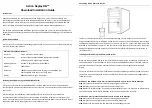
If several through-beam photoelectric sensors which are installed next to one ano‐
ther are to be used, we recommend swapping the sender / receiver arrangement
at every second through-beam photoelectric sensor and ensuring that there is suf‐
ficient distance between the through-beam photoelectric sensors. By doing this,
mutual interference can be prevented [cf. F].
0
1,000
100
10
1
Operating reserve
10
(32.81)
5
(16.40)
20
(65.62)
15
(49.21)
25
(82.02)
Distance in m (feet)
0
1,000
100
10
1
Operating reserve
10
(32.81)
5
(16.40)
20
(65.62)
15
(49.21)
25
(82.02)
Distance in m (feet)
Image: H
HSE18-xxx1xx
Image: H-2
HSE18-xxx2xx
2
Mount sensors (sender and receiver) using suitable mounting brackets (see the
SICK range of accessories). Align the sender and receiver with each other.
Note the sensor's maximum permissible tightening torque of 0.56 Nm.
3
The sensors must be connected in a voltage-free state (U
v
= 0 V). The information
in the graphics [B] must be observed, depending on the connection type:
–
Male connector connection: pin assignment
–
Cable: core color
Only apply voltage/switch on the power supply (U
v
> 0 V) once all electrical connec‐
tions have been established. The green LED indicator on the top of the sensor
lights up.
Explanations of the connection diagram (Graphic B):
Switching outputs Q and /Q (according to Graphic B):
Switching output Q (according to Graphic B):
HSE18-P (PNP: load -> M)
HSE18-N (NPN: load -> L+)
L = light switching
D = dark switching
Alarm / Health = diagnostics output (see Additional functions)
TI / Test = test input (see Additional functions)
4
Red light: Align the sender with the receiver. Select the position so that the red
emitted light beam hits the receiver. Tip: The signal strength light bar on the rear of
the sensor will help to ensure correct alignment. Use white paper or a reflector as
an alignment aid. The sender must have a clear view of the receiver, with no object
in the path of the beam [see Graphic E]. You must ensure that the optical openings
(front screen) of the sensors are completely clear.
Infrared light: Align the sender with the receiver. Select the position so that the inf‐
rared light (not visible) hits the receiver. Use the signal strength light bar on the re‐
ar of the sensor to determine the correct alignment. Please refer to Graphics E and
3
COMMISSIONING
2
8017854 | SICK
Subject to change without notice
Technical data and connection diagrams (figure B) starting on page 63.
Содержание SureSense HSE18 Series
Страница 44: ...55 56 HSE18 HS HE SICK AG HSE18 EMC A Image A 8017854 SICK Subject to change without notice 43...
Страница 50: ...64 EU 65 HSE18 HS HE SICK AG HSE18 EMC A Image A 8017854 SICK Subject to change without notice 49...
Страница 57: ...73 74 HSE18 HS HE SICK AG HSE18 A Image A 56 8017854 SICK Subject to change without notice...




































